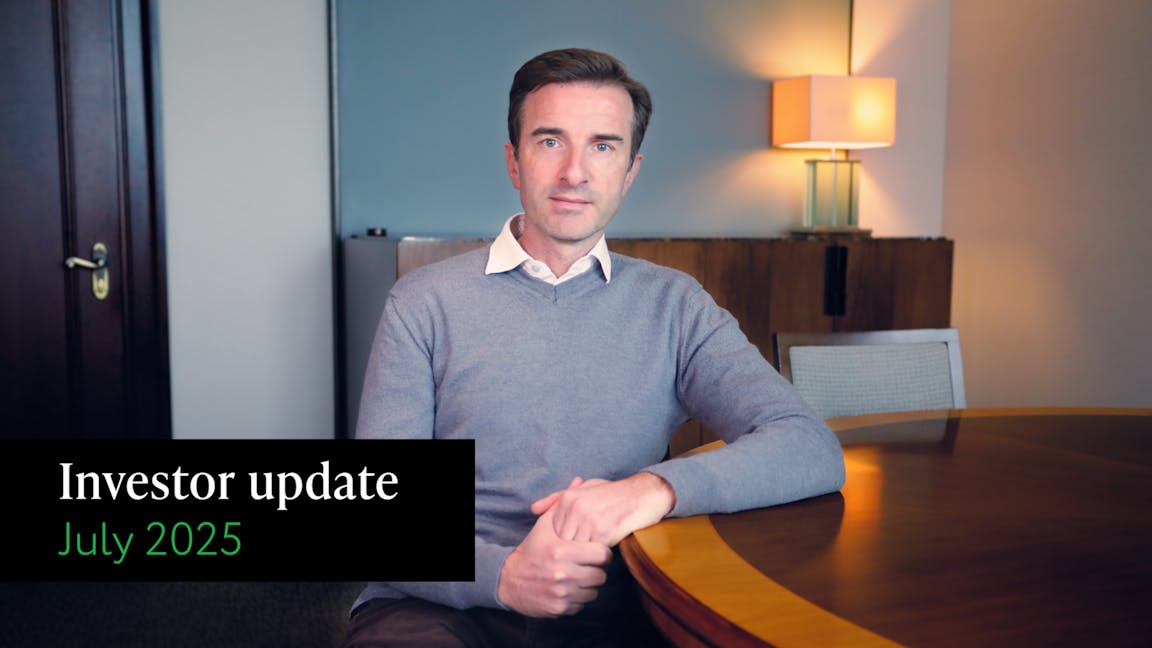
June was a strong month for many financial markets. Discussions progressed between the US and its trading partners, bolstering investor confidence. Pacome Breton, Head of Portfolio Management, reviews the month and reflects on the first half of the year.
At a glance:
- In June, we changed our equity view to ‘overweight’, meaning our outlook is increasingly positive. We have seen easing trade tensions, which have increased confidence in the US economy.
- There were particularly strong returns from US and emerging market stocks in June, while short-term and long-term bonds in the UK and the US performed well. This helped our portfolios to perform positively.
- It closes out a busy first half of the year. It was marked by: tariff uncertainty, April's heightened market volatility and the swift recovery many markets saw soon after, as well as a resurgent Europe.
Were there any key portfolio changes made in June?
We changed our equity view to ‘overweight’ in June, meaning our outlook is increasingly positive. This follows an improvement in discussions between the US and its trade partners and increased confidence in the resilience of US economic growth. This view has been reflected across risk levels.
For higher risk levels, where we have greater exposure to equities, we have further increased holdings. We have reduced our fixed income exposure to do this, mainly trimming holdings in government bonds. We anticipate upward pressure on long-term bond yields due to high budget deficits on both sides of the Atlantic. We have reduced our exposure to these assets to account for this.
Given recent strength in equity market performance, the equity exposure in our lower-risk portfolios has gradually increased. While we believe the equity outlook has improved and this would typically mean increasing holdings, to maintain the risk profiles of these lower-risk portfolios we have trimmed their equity holdings.
Geopolitically, June was highly eventful. Has this impacted markets?
This month was quieter on the macro-economic front. Inflation appeared to be cooling, and employment data remained supportive in the US, easing recession risk fears. Events in the Middle East had limited, albeit not insignificant, impact on markets and oil prices, something almost unthinkable a few years back.
In terms of market performance, June was a strong continuation of what was seen in May. In equities, there was strong performance from the US, leading returns, along with emerging markets. In fixed income, both short-term and long-term bonds performed positively, in both the UK and the US markets. This strong equity and fixed income performance helped our portfolios to perform positively.
It is worth noting the strength of the pound, which impacts our portfolios. While our fixed income allocation is entirely in sterling assets or GBP-hedged assets, our equity exposure is only partially hedged. Therefore, for higher-risk portfolios, while they benefited significantly in June from positive equity performance, the strength of the pound is diminishing the positive contribution, given our exposure to equity markets outside the UK. The impact has been pronounced this year with the pound up almost 10% versus the US dollar. We look at this topic in greater detail in a recently published article.
How do you view the first half of the year?
The first part of the year, especially the second quarter, has been almost unprecedented in terms of uncertainty. This was induced by the proposition to implement the largest tariffs in the US since the 1930s, a proposition that was reversed abruptly just a couple of days later. The impact on financial markets was extremely sharp, with one of the worst short-term losses for equity markets, soon followed by a strong recovery.
By modestly reducing our equity exposure and gradually re-introducing risk in May and June, we aimed to focus on long-term objectives. Trying to time short-term fluctuations in the markets remains hazardous, especially when they are induced by political decisions that can be quickly reversed.
One of the most impactful aspects of this first half of 2025 was the resurgence of Europe. Germany announced plans to increase its military spending to levels above any previous forecasts with a budget containing fiscal stimulus unprecedented since the German reunification in the 1990s. This has the potential to be a long-term game changer for Europe and could bring a renewed level of dynamism to the old continent.
How do you reflect on April's tariff-induced market volatility?
The shock and the size of the US Republican Administration's tariff proposals were clearly beyond any market forecasts at the time, and it was no surprise that the market reacted so strongly. The situation remains fragile, and it is difficult to fully understand the tactics of the US president and his administration.
Our current belief is leaning towards a scenario where:
- tariffs, while elevated compared to history, will settle at a much lower level, and
- growth will remain largely positive, even if lower than initially anticipated.
The weakness of the US dollar, reflecting this level of uncertainty, will help US companies and their profit margins, while Europe continues to look relatively attractive for the reasons mentioned previously. The situation continues to remain challenging on the macro front in China, even though its technological sector continues to innovate. We are therefore cautiously optimistic for the rest of the year but volatility and uncertainty is likely to remain elevated.
About this update: All figures, unless otherwise stated, relate to the month of June 2025.
Sources: MacroBond, Nutmeg and Bloomberg.
Risk warning
As with all investing, your capital is at risk. The value of your portfolio with Nutmeg can go down as well as up and you may get back less than you invest. Past performance and forecasts are not a reliable indicator of future performance. We do not provide investment advice in this update. Always do your own research.



